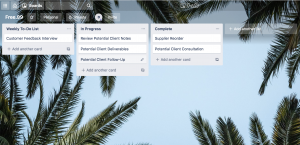Even when times are great, it’s hard to beat Free.99! Given our 2020 reality and everyone’s desire to tighten their belt, this short post is dedicated to some of the free apps and tools we use—most of them on a daily basis.
We used to dream of the day we could use paid apps. Yes, we thought business life would be better when the premium features of our tools were no longer locked. Fortunately, we’ve had some success and we do pay for a few essential apps. But for the most part, free apps are still the backbone of my day-to-day operations. Maybe you can consider adding one of these to your arsenal.
Google Analytics
We guarantee the analytics of your Shopify, WordPress, Wix, etc. dashboard are not telling you enough. For free, Google Analytics will show where your visitors are coming from, how long they’re staying, and even what type of device they’re using to purchase your product or service. Information is like gold. Maybe you don’t want to check data all the time, but you want to at least have it.
If you aren’t tech savvy, no worries. Setting up Google Analytics doesn’t require coding. And below we’ve included setup videos for a few of the major hosting platforms:
- Google Analytics Setup For WordPress
- Google Analytics Setup For Shopify
- Google Analytics Setup For Wix
- Google Analytics Setup For Squarespace
Google Drive
Google is not paying us for this article—if they wanted to though, we’d accept a few coins. The Bold team is four people strong and Google Drive is the perfect, free way for us to share a workspace. Videos, meeting notes, and other business documents live in our shared workspace.
Having a free, communal place in the cloud beats constantly emailing each other things back and forth. We check them out when necessary, and even collaborate to edit projects like slide decks in real time. All you need is a gmail email (and if you’re fancy like us you can upgrade to have your website domain replace gmail.com and get other add-ons).
Airtable
Lately we’ve gotten several comments about how active we’ve been on social media. We appreciate the love! To be transparent, we’ve set daily and weekly posting expectations that are much more ambitious than our goals in the past.
When you’re posting about fifteen times a day across social media accounts, you need a tool to keep everything in order. Airtable is that tool for us.
Calling our system a content calendar might be a stretch. We’ve learned that rather than trying to plan out an entire month or even week’s worth of posts is probably too rigid. But we use Airtable to get our ideas in one place—in draft form—and that way we’re flexible and ready to post on Instagram, Facebook, Twitter, etc. Over time you’ll find a system that works for you and your team.
Canva
If you need to whip up graphics or resize photos, Canva has what you need. It has templates for any type of flyer, menu, or collage that you can imagine in your head. We’ve used Canva for anything from quickly throwing together a thumbnail image for one of our videos to meticulously designing multiple types of business cards. All for free.
Despite now spending much more time with Adobe products (some of those essential paid apps we mentioned at the beginning), when we need to make quick design edits, we find ourselves running back to Canva.
Our cofounder Doug is a sandwich guy. Sometimes he might want a sandwich with fancy mustard, pickles, lettuce—the works. But often times the ol’ faithful peanut butter and jelly is fast and will hit the right spot. Canva is like the work version of a peanut butter and jelly sandwich. Quick, easy, and gets the job done very well.
Trello
We love a minimalist yet sleek and functional layout—we hope that’s reflected in the design of Grow Bold and Bold Xchange. For us, Trello fits that mold perfectly.
Have you ever heard of a Kanban Board? In short, it’s a system designed to help you manage projects efficiently. Every business owner has several projects going at one time. It’s almost impossible to keep track of them all, and inevitably you’re going to drop the ball on one of them. Trello is the best tool we’ve used yet to help me eliminate avoidable project management mistakes.
Here’s a simple example of how we use Trello. Hypothetically, this week we have to interview a customer for feedback on our products, do a consultation with a potential client, and call a supplier to coordinate a reorder.

We can use Trello to visually map these tasks and their underlying parts. When a task transitions from not yet started to in progress or to finally complete, we can drag it to the right pile. We like to at least know what we’re juggling and what we’re about to throw into the mix. And knowing what’s finished helps, too.
Conclusion
These are just five tools, five that make the Bold team’s work life much easier. There are countless other free tools out there. The point is, if you’re looking for ways to cut business expenses and help you create calm amidst the current chaos, you can find worthwhile solutions without opening your wallet.

